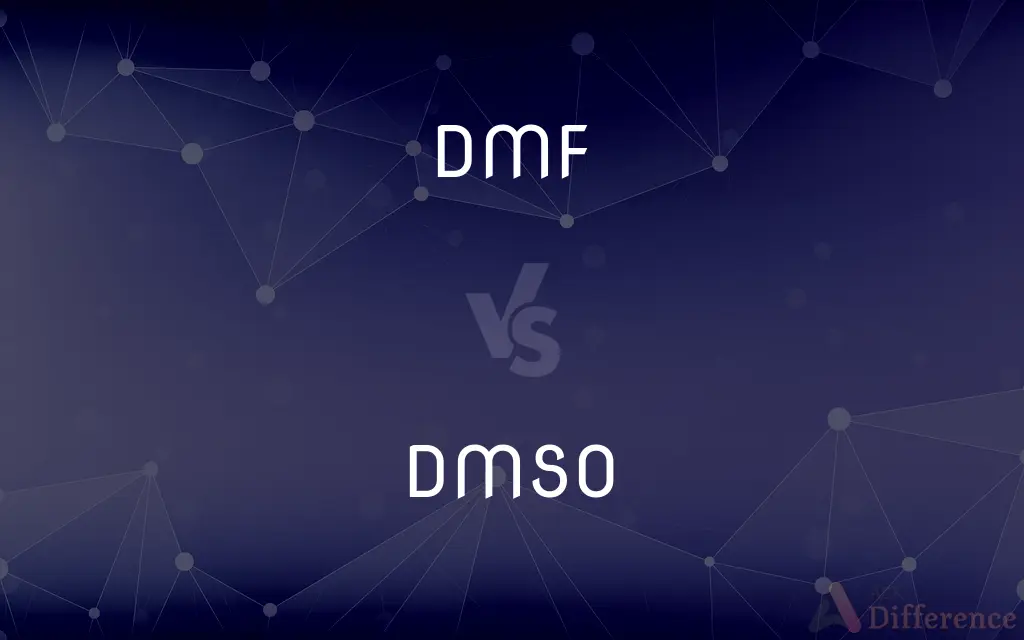DMF vs. DMSO — What's the Difference?
By Tayyaba Rehman & Fiza Rafique — Published on February 17, 2024
DMF (Dimethylformamide) and DMSO (Dimethyl sulfoxide) are polar aprotic solvents, with DMF being used mainly in industrial and chemical reactions and DMSO as a solvent and in medicine.

Difference Between DMF and DMSO
Table of Contents
ADVERTISEMENT
Key Differences
DMF (Dimethylformamide) and DMSO (Dimethyl sulfoxide) are both polar aprotic solvents, highly effective in dissolving a wide range of organic and inorganic compounds. DMF, with its high boiling point and ability to facilitate reactions under high temperatures, is extensively used in chemical synthesis and industrial applications, including the production of polymers and pharmaceuticals. Its ability to dissolve a wide variety of substances makes it invaluable in the manufacturing and chemical processing industries.
DMSO, on the other hand, is not only a powerful solvent used in chemical laboratories for its ability to dissolve both polar and nonpolar compounds but also has significant medical applications due to its unique properties, including penetrating biological membranes and acting as an anti-inflammatory agent. Its use extends beyond industrial and laboratory settings into medicine, where it is applied topically to reduce pain and inflammation.
The key difference between DMF and DMSO lies in their applications and safety profile. While both are used as solvents in the chemical industry, DMSO's biological properties have made it a compound of interest in pharmaceuticals and medical treatment, offering therapeutic benefits that DMF does not. DMF is primarily utilized for its chemical properties in synthesis and manufacturing processes, where its high boiling point and solvation capabilities are advantageous.
Additionally, the safety considerations for handling these solvents differ significantly. DMSO is known for its relatively low toxicity and ability to be used in direct contact with human skin, whereas DMF requires more stringent handling precautions due to its potential toxic effects, particularly in occupational settings where prolonged exposure can occur.
In summary, while DMF and DMSO share similarities as polar aprotic solvents, their distinct physical and chemical properties dictate their specific uses in chemical synthesis, industrial applications, and medical treatments. The choice between DMF and DMSO depends on the requirements of the application, considering factors such as solvent strength, boiling point, and safety profile.
ADVERTISEMENT
Comparison Chart
Primary Use
Industrial and chemical synthesis
Solvent in lab, medicine
Boiling Point
Higher than DMSO
Lower than DMF
Solvation Capability
Excellent for polar and nonpolar compounds
Similarly excellent, with unique biological properties
Medical Applications
Limited
Widely used as a topical medication and solvent in pharmaceuticals
Safety Profile
Toxic, requires careful handling
Lower toxicity, can be applied topically
Compare with Definitions
DMF
Known for its high boiling point.
DMF's high boiling point makes it ideal for applications requiring thermal stability.
DMSO
Penetrates biological membranes, aiding in drug delivery.
The ability of DMSO to cross skin makes it valuable in transdermal drug formulations.
DMF
Requires precautions due to toxicity.
When using DMF, ensure proper ventilation and protective equipment.
DMSO
A solvent with significant medical and pharmaceutical applications.
DMSO is used topically to relieve joint pain due to its anti-inflammatory properties.
DMF
Solubilizes many organic and inorganic compounds.
DMF can dissolve substances that are otherwise insoluble in water.
DMSO
Exhibits low toxicity, making it safe for topical application.
Due to its low toxicity, DMSO is one of the few solvents safe for direct skin contact.
DMF
A polar aprotic solvent used in chemical synthesis.
DMF is crucial for facilitating reactions that require high temperatures.
DMSO
Facilitates cryopreservation due to its cell membrane penetration.
DMSO is commonly used in cryopreservation to protect cells during freezing.
DMF
Utilized in the production of polymers and fibers.
Acrylic fibers are often produced using DMF as a solvent.
DMSO
Used in laboratories for its ability to dissolve a wide range of compounds.
DMSO is a staple solvent in organic chemistry labs for its versatility.
DMSO
A colorless hygroscopic liquid, (CH3)2SO, obtained from lignin, used as an industrial solvent and in medicine as a penetrant to convey medications into the tissues.
Common Curiosities
Why is DMF preferred in industrial applications?
Its high boiling point and ability to dissolve a wide range of materials make it suitable for chemical synthesis.
Can DMF be used in medical applications?
Its use is limited due to toxicity concerns.
Is DMSO safe for topical application?
Yes, due to its low toxicity, it's used for pain and inflammation relief.
How do DMF and DMSO differ in boiling points?
DMF has a higher boiling point, making it stable at higher temperatures.
What are DMF and DMSO?
Both are polar aprotic solvents, with DMF used in industrial processes and DMSO in medicine and as a solvent.
What are the safety concerns with DMF?
It's toxic and requires careful handling to avoid exposure.
Can DMSO dissolve nonpolar compounds?
Yes, it can dissolve both polar and nonpolar substances.
Why is DMSO used in cryopreservation?
It prevents ice crystal formation, protecting cells.
What makes DMSO useful in medical treatments?
Its anti-inflammatory properties and ability to penetrate skin.
Is DMF used in polymer production?
Yes, particularly in the manufacture of acrylic fibers.
How does DMSO aid in drug delivery?
It penetrates biological membranes, facilitating transdermal drug transport.
What are the main laboratory uses of DMSO?
Solvent for reactions and for dissolving samples.
Can DMSO be ingested?
While it has low toxicity, ingestion without medical supervision is not recommended.
What precautions are necessary when handling DMF?
Use in a well-ventilated area with protective gear to avoid inhalation and skin contact.
How are DMF and DMSO similar?
Both are polar aprotic solvents capable of dissolving a wide range of substances.
Share Your Discovery

Previous Comparison
Anorexia vs. Anorexia Nervosa
Next Comparison
TQM vs. TQCAuthor Spotlight
Written by
Tayyaba RehmanTayyaba Rehman is a distinguished writer, currently serving as a primary contributor to askdifference.com. As a researcher in semantics and etymology, Tayyaba's passion for the complexity of languages and their distinctions has found a perfect home on the platform. Tayyaba delves into the intricacies of language, distinguishing between commonly confused words and phrases, thereby providing clarity for readers worldwide.
Co-written by
Fiza RafiqueFiza Rafique is a skilled content writer at AskDifference.com, where she meticulously refines and enhances written pieces. Drawing from her vast editorial expertise, Fiza ensures clarity, accuracy, and precision in every article. Passionate about language, she continually seeks to elevate the quality of content for readers worldwide.












































